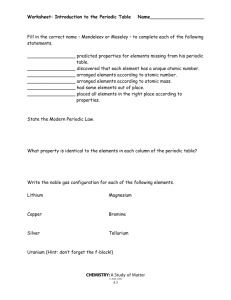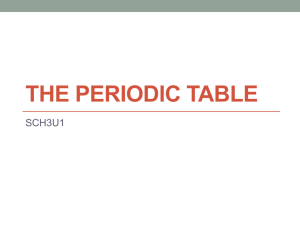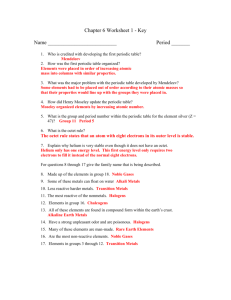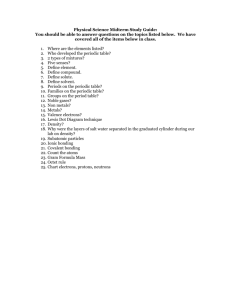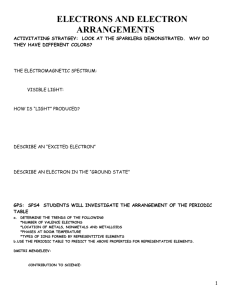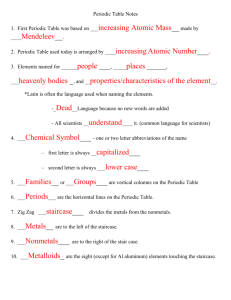Document
advertisement
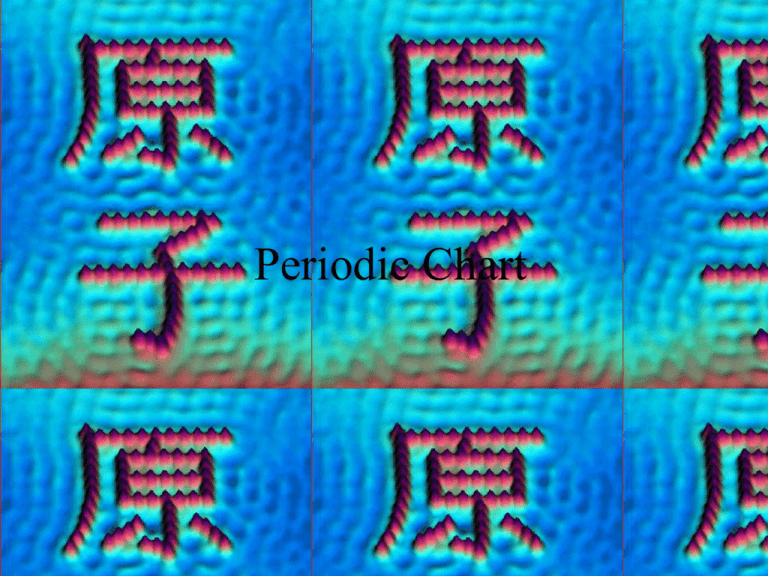
Periodic Chart Diderot's Alchemical Chart of Affinities (1778) Where to begin • Dobereiner observes similarities in elements. Proposes Law of Triads-Middle element in the triad had atomic weight that was the average of the other two members. First Periodic Table 1862 • Alexandre Beguyer de Chancourtois (18201886), professor of geology at the School of Mines in Paris, publishes a periodic table constructed as a helical graph. • Ignored Helix Periodic Table John Newlands proposes Octet rule having arranged the 62 known elements in order of increasing atomic weights, noted that after interval of eight elements similar physical/chemical properties reappeared. • Because these properties seemed to repeat every eight elements, Newlands called this pattern the law of octaves. More Periodic History • Mendeleev • Then in 1869, Russian chemist Dimitri Mendeleev (1834-1907) proposed arranging elements by atomic weights and properties (Lothar Meyer independently reached similar conclusion but published results after Mendeleev). Mendeleev noticed that the chemical properties of the elements repeated each time he started a new row. • Mendeleev made two interesting observations 1. Mendeleev’s table contains gaps that elements with particular properties should fill. 2. The elements do not always fit neatly in order of atomic mass. • Mendeleev predicted the properties of the missing elements. Mendeleev’s Periodic Chart More Mendeleev • Mendeleev's periodic table of 1869 contained 17 columns with two partial periods of seven elements each (Li-F & Na-Cl) followed by two nearly complete periods (K-Br & Rb-I). Mendeleev Periodic Table Mendeleev’s Periodic Law • Properties of the elements is a periodic function of their atomic mass Why Mendeleev’s basic version of the periodic chart? • Mendeleev/Meyer periodic chart is the basis of today’s chart because it: – Predicts Atomic Properties – Indicates Trends – Indicates groups that will react/not react together Mosley Periodic Table • After Rutherford’s experiments • Henry Moseley (1887-1915) subjected known elements to x-rays. He was able to derive the relationship between x-ray frequency and number of protons. Modern Periodic Law • Mosley’s Periodic Law- Properties of an element are a periodic function of their atomic number. Mosley’s Periodic Table •When the elements were arranged by increasing •atomic number, the discrepancies in •Mendeleev’s table disappeared. • Moseley’s work led to both the modern definition of atomic number, and showed that atomic number, not atomic mass, is the basis for the organization of the periodic table. Last Major Change • Gene Seaborg • Starting with plutonium in 1940, Seaborg discovered transuranium elements 94 to 102 and reconfigured the periodic table by placing the lanthanide/actinide series at the bottom of the table. In 1951 Seaborg was awarded the Nobel Prize in chemistry and element 106 was later named seaborgium (Sg) in his honor. Modern Periodic Law • Mendeleev’s principle of chemical periodicity is known as the periodic law, which states: • The elements are arranged according to their atomic numbers, elements with similar properties appear at regular intervals. A Little More about Mendeleev and the Periodic Table S.E. Van Bramer, 9/11 Modified 7/22/99 1 F Block Placed in the Periodic Table H 3 Li 1 H He 4 5 Be B C 11 12 6 7 8 9 10 N O F Ne 13 14 15 16 17 18 Na Mg 19 20 2 Al Si P S Cl Ar K Ca 21 22 23 24 25 26 27 28 29 30 31 32 33 34 35 36 Sc Ti V Cr Mn Fe Co Ni Cu Zn Ga Ge As Se Br Kr 37 38 Rb Sr 39 40 41 42 43 44 45 46 47 48 49 50 51 52 53 54 Xe Y Zr Nb Mo Tc Ru Rh Pd Ag Cd In Sn Sb Te I 55 56 57 58 59 60 61 62 63 64 65 66 67 68 69 70 71 72 73 74 75 76 77 78 79 80 81 82 83 84 85 86 Cs Ba La Ce Pr Nd Pm Sm Eu Gd Tb Dy Ho Er Tm Yb Lu Hf Ta W Re Os Ir Pt Au Hg Tl Pb Bi Po At Rn 87 88 89 90 91 92 93 94 95 96 97 98 99 100 101 102 103 104 105 106 107 108 109 110 111 112 Fe Ra Ac Th Pa U Np Pu Am Cm Bk Cf Es Fm Md No Lr Rf Db Sg Bh Hs Mt 114 116 118 Circular Periodic Table Kansas Board Approved Periodic Table 4 Main Blocks More Periodic Table • Period - rows of elements with the same energy level • Groups - elements in the same column with the same electron configuration • Metals- left of metalloids • Nonmetals- rt of metalloids Majority of elements are metals Special names for Some Main Groups • Four groups within the main-group elements have special names. These groups are: • alkali metals (Group 1) • alkaline-earth metals (Group 2) • halogens (Group 17) • noble gases (Group 18) Elements in Group 1 are called alkali metals. lithium, sodium, potassium, rubidium, cesium, and francium • Alkali metals are so named because they are metals that react with water to make alkaline solutions. • Because the alkali metals have a single valence electron, they are very reactive. • In losing its one valence electron, potassium achieves a stable electron configuration. • Alkali metals are never found in nature as pure elements but are found as compounds. Group 2 elements are called alkaline-earth metals. • The alkaline-earth metals are slightly less reactive than the alkali metals. • They are usually found as compounds. • The alkaline-earth metals have two valence electrons and must lose both their valence electrons to get to a stable electron configuration. • It takes more energy to lose two electrons than it takes to lose just the one electron that the alkali metals must give up to become stable. Elements in Group 17 of the periodic table are called the halogens. • The halogens are the most reactive group of nonmetal elements. • When halogens react, they often gain the one electron needed to have eight valence electrons, a filled outer energy level. • Because the alkali metals have one valence electron, they are ideally suited to react with the halogens. • The halogens react with most metals to produce salts. Group 18 elements are called the noble gases. • The noble gas atoms have a full set of electrons in their outermost energy level. • The low reactivity of noble gases leads to some special uses. • The noble gases were once called inert gases because they were thought to be completely unreactive. • In 1962, chemists were able to get xenon to react, making the compound XePtF6. • In 1979, chemists were able to form the first xenon-carbon bonds. Hydrogen • Hydrogen is in a class by itself in the periodic table • It is placed in group 1 because it has a 1+ charge and a 1s1 electron configuration • It can also be placed in Group 17 because of its behavior as well Periodicity • With increasing atomic number, the electron configuration of the atoms display a periodic variation. • Which leads us to Trends Trends • Atomic radii – One-half the diameter of the distance between two like nuclei – Increases down a group – Decreases across a period Different Atomic Radii Ionic Radii Radius of the ion after it has lost or gained an electron - increases across the chart - increases down the chart Ionization Energy • Amount of energy required to remove an electron from an atom – Increases across the chart – Decrease down the chart Electron shielding • is the reduction of the attractive force between a positively charged nucleus and its outermost electrons due to the cancellation of some of the positive charge by the negative charges of the inner electrons. Electron Affinity • The energy emitted upon the addition of an electron to an atom or group of atoms in a gas phase – Generally become more negative as you go across the chart\ – No clear trend Other trends • Increase in Atomic Number and Mass • Melting and Boiling Points -metals increase L-R then decrease to nonmetals • Electronegtivity – Energy required by an element in a compound to attract an electron - increase from L-R - decrease top to bottom Trends in Melting Point

